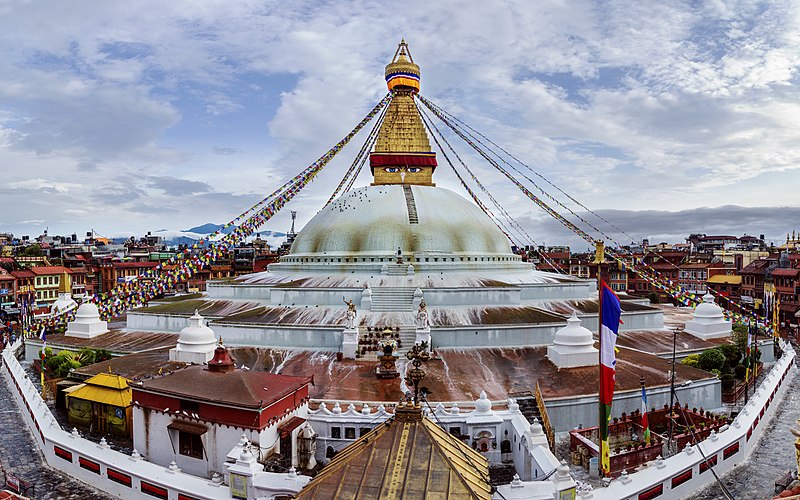Nestled in the vibrant heart of Kathmandu Valley, the Boudhanath Stupa stands as one of Nepal’s most significant and impressive monuments. This iconic stupa, also known as Boudha, serves as a focal point of Tibetan Buddhism in Nepal and attracts thousands of pilgrims and tourists each year.
Boudhanath’s origins trace back to the 5th century AD. According to legend, it was constructed during the reign of King Śivadeva and later restored by the Licchavi rulers. The stupa has been an important place of pilgrimage and meditation for Tibetan Buddhists and local Nepali Buddhists since its inception. Its immense mandala makes it one of the largest spherical stupas in Nepal, symbolizing the mind of the Buddha.
The stupa’s architectural grandeur is a sight to behold. Rising to an impressive height, its massive mandala base supports a white dome, topped with a gilded tower featuring the all-seeing eyes of Buddha. The eyes, painted on each of the four sides of the tower, represent Buddha’s omnipresent wisdom and compassion. The structure is encircled by hundreds of prayer wheels, and the scent of incense and the sound of monks chanting adds to the spiritual ambiance.
Boudhanath is not only an architectural wonder but also a cultural treasure. It is a UNESCO World Heritage Site, recognized for its outstanding universal value. The stupa has been a crucial center for Tibetan culture and religion since the 1950s when many Tibetans fled to Nepal following the Chinese invasion. The surrounding area, known as “Little Tibet,” is filled with Tibetan monasteries, shops, and restaurants, creating a vibrant community that celebrates Tibetan traditions and lifestyle.
Boudhanath is a magnet for both pilgrims and tourists. The stupa is surrounded by a circular path, allowing visitors to perform kora (circumambulation) while spinning prayer wheels and reciting mantras. The rooftop restaurants and cafes offer stunning stupa views, making them perfect spots to relax and soak in the serene atmosphere.
Festivals such as Losar (Tibetan New Year) and Buddha Jayanti are celebrated with great enthusiasm at Boudhanath, drawing large crowds and creating a lively and festive environment. These events provide a unique opportunity for tourists to witness and participate in traditional Tibetan rituals and celebrations.
Preserving the stupa’s integrity and heritage is a continuous effort. After the devastating earthquake in 2015, which caused significant damage, a major restoration project was undertaken to rebuild and reinforce the structure. The local community, along with international organizations, played a crucial role in restoring Boudhanath to its former glory.
For those planning to visit Boudhanath, the best time is during the early morning or late afternoon when the crowds are thinner, and the stupa is bathed in soft sunlight. The peaceful ambiance during these times enhances the spiritual experience, allowing visitors to connect deeply with the site’s profound energy.
Boudhanath Stupa is a testament to Nepal’s rich cultural and religious heritage. Its historical significance, architectural beauty, and vibrant cultural milieu make it a must-visit destination for anyone traveling to Nepal. Whether you seek spiritual enlightenment, cultural immersion, or simply a moment of tranquility, Boudhanath offers an experience like no other.






